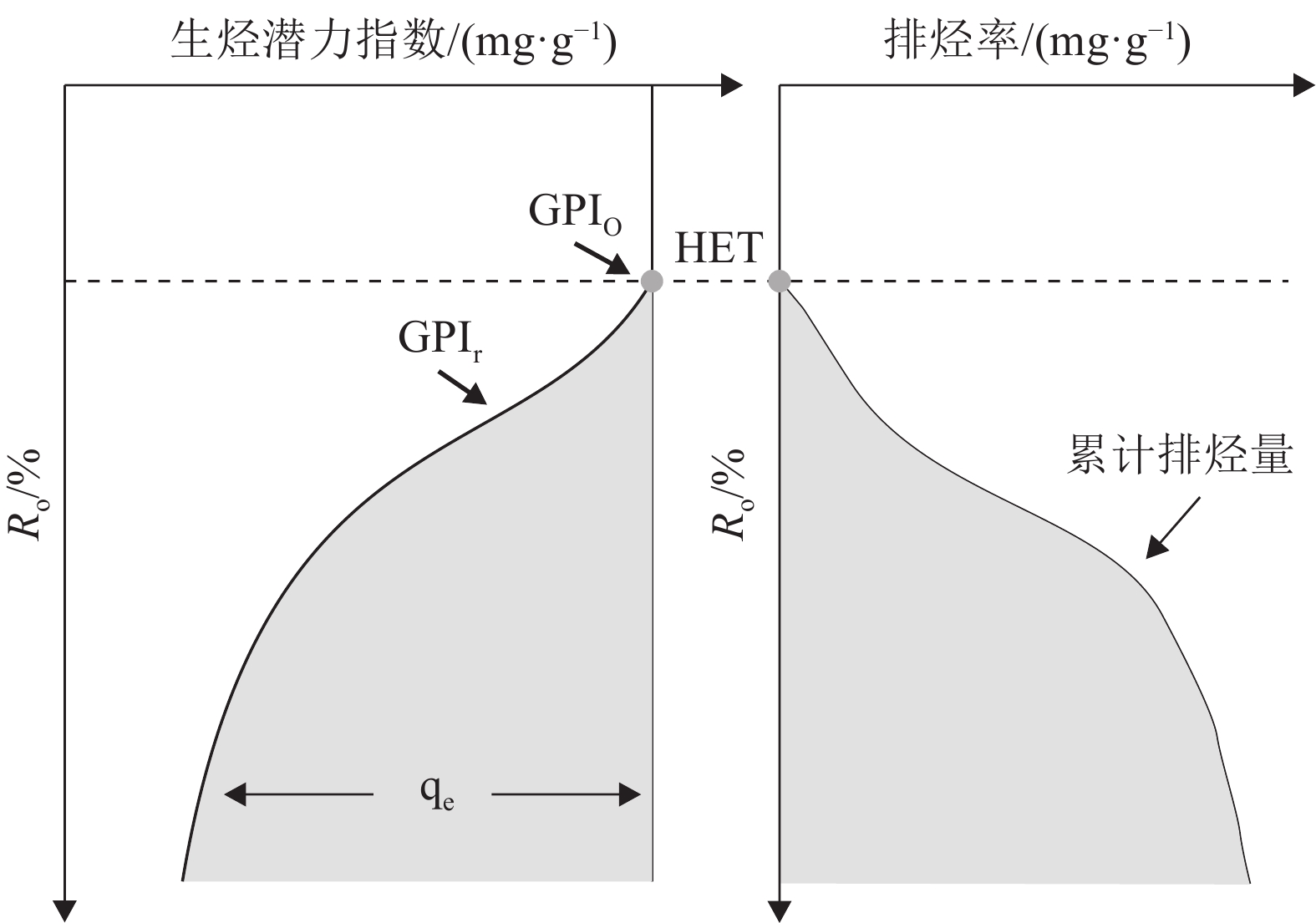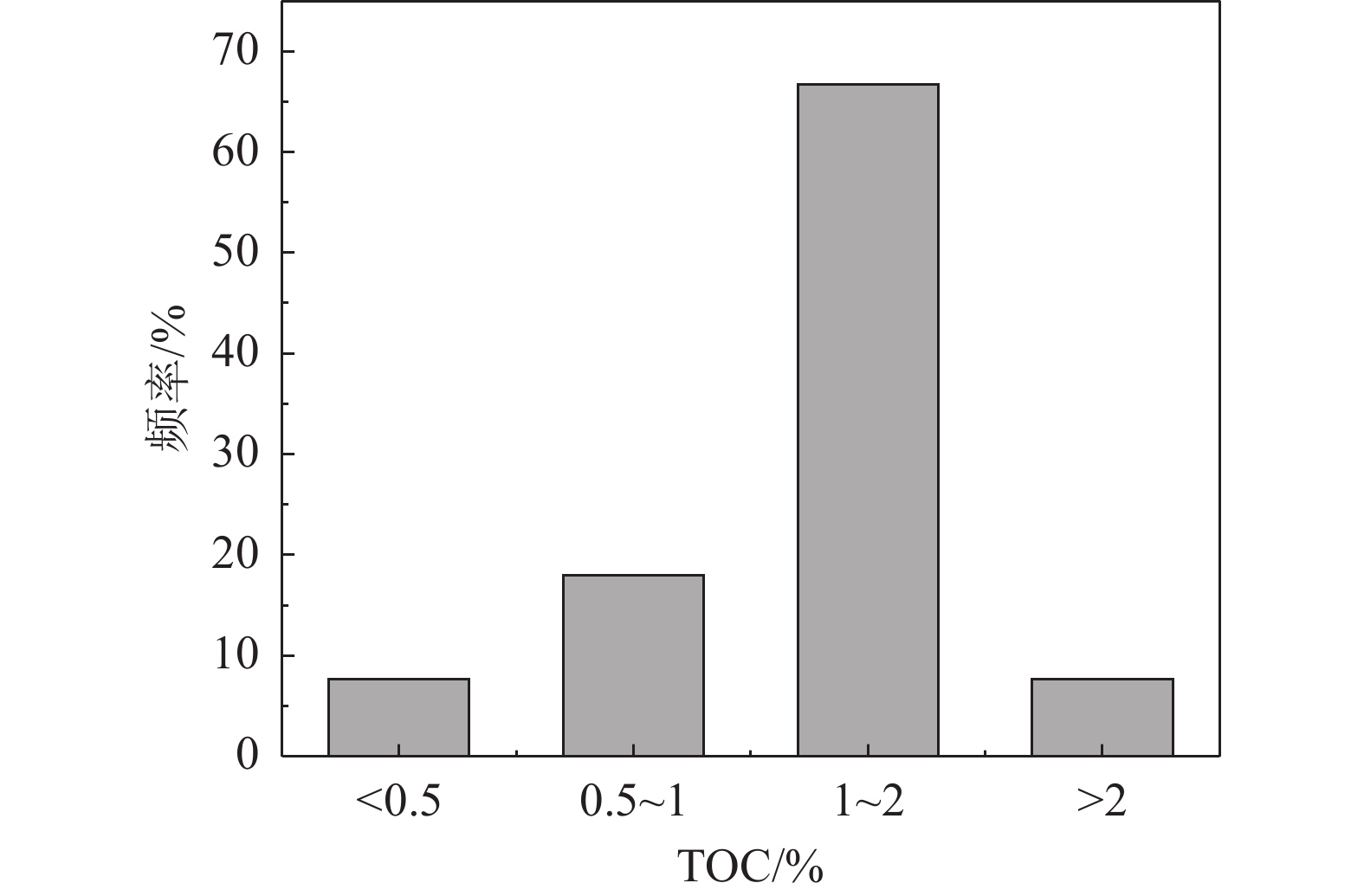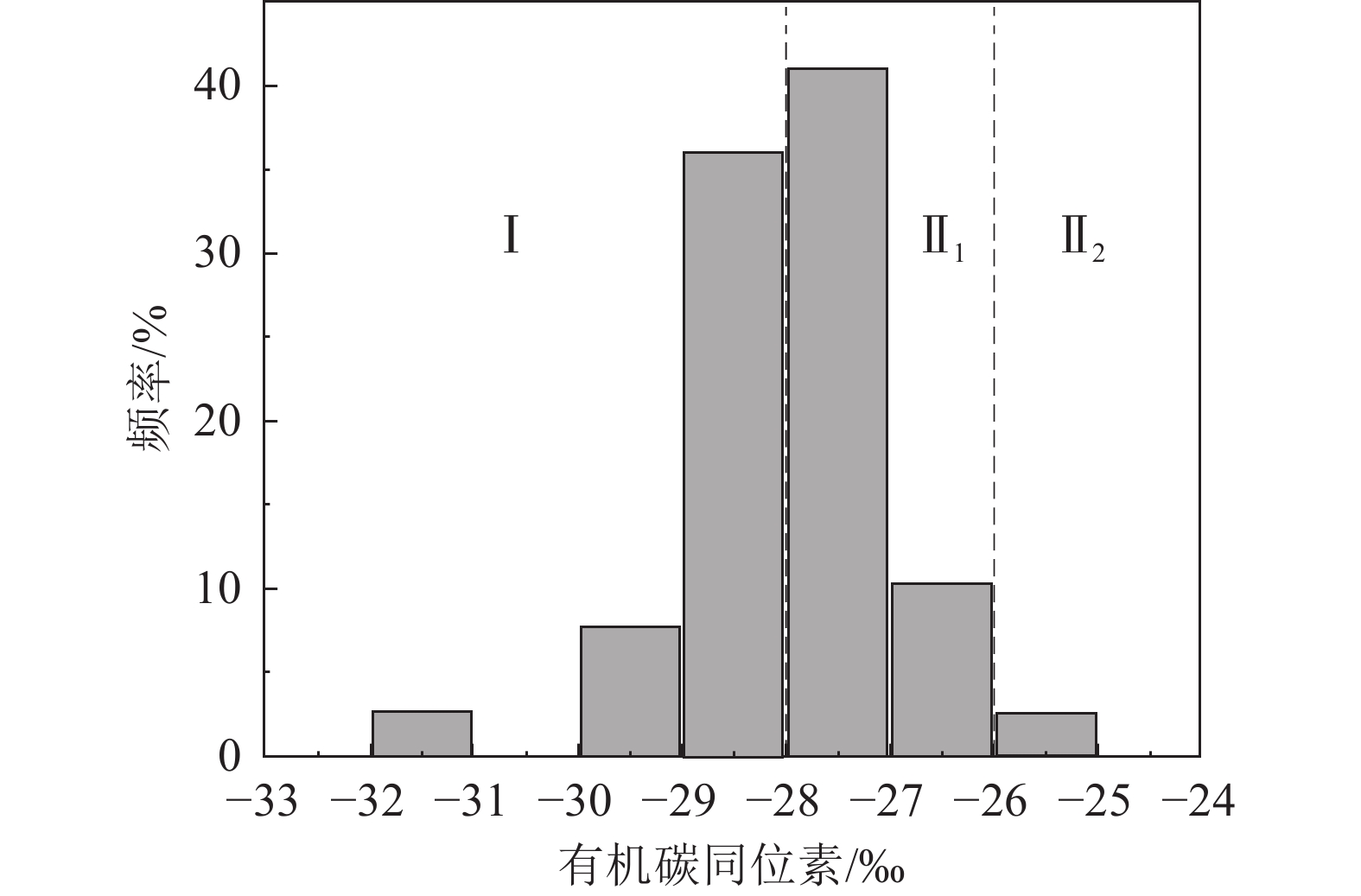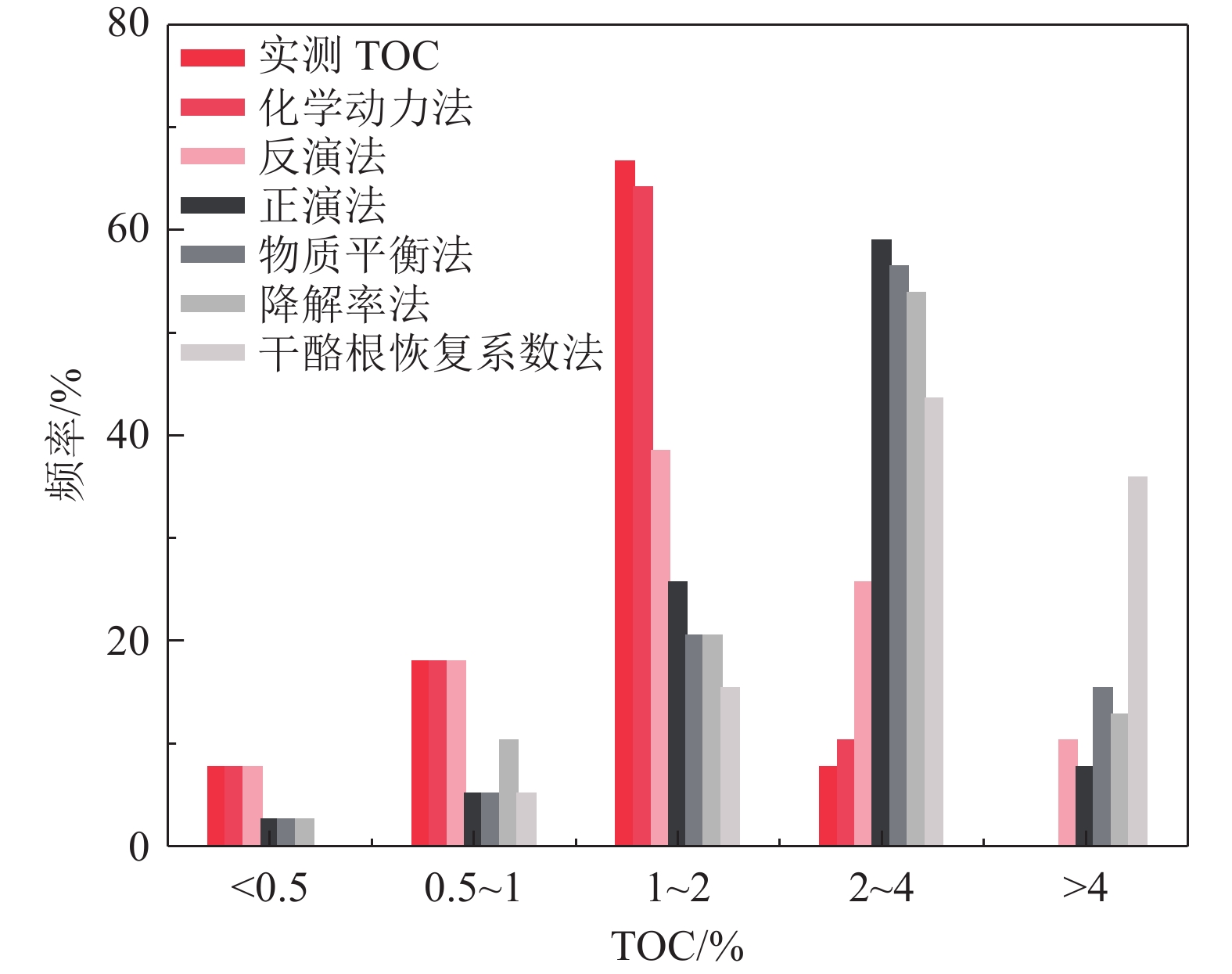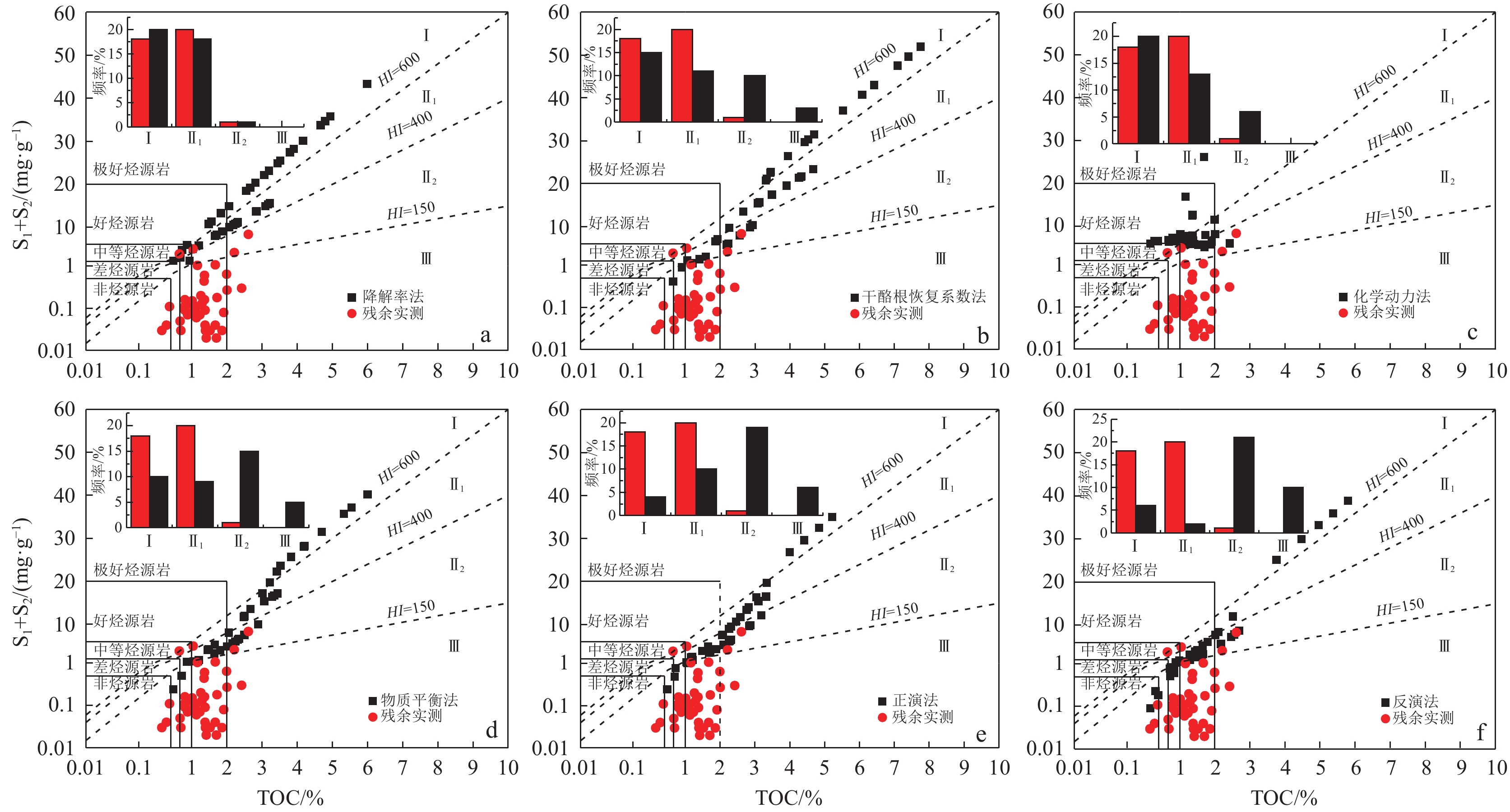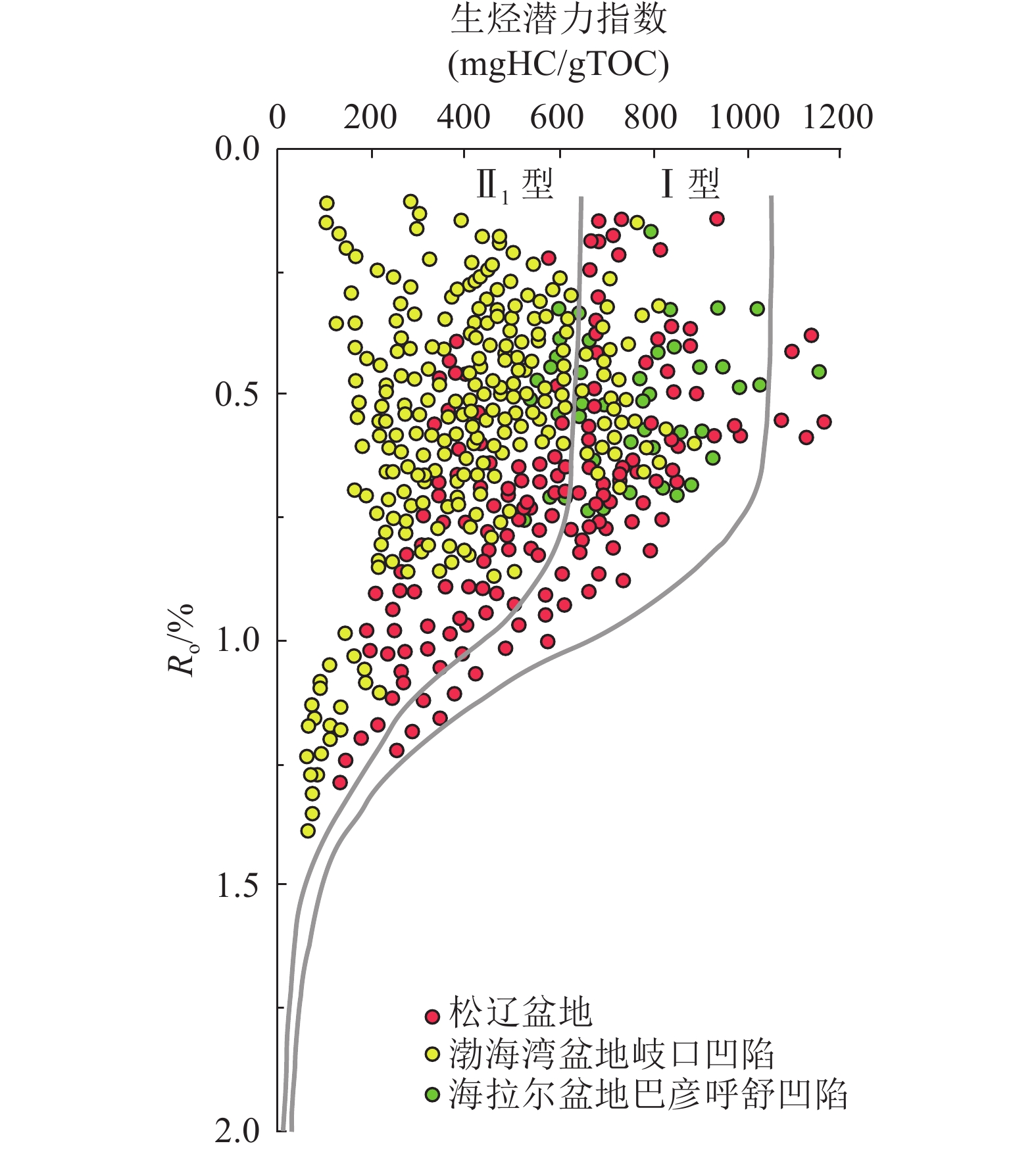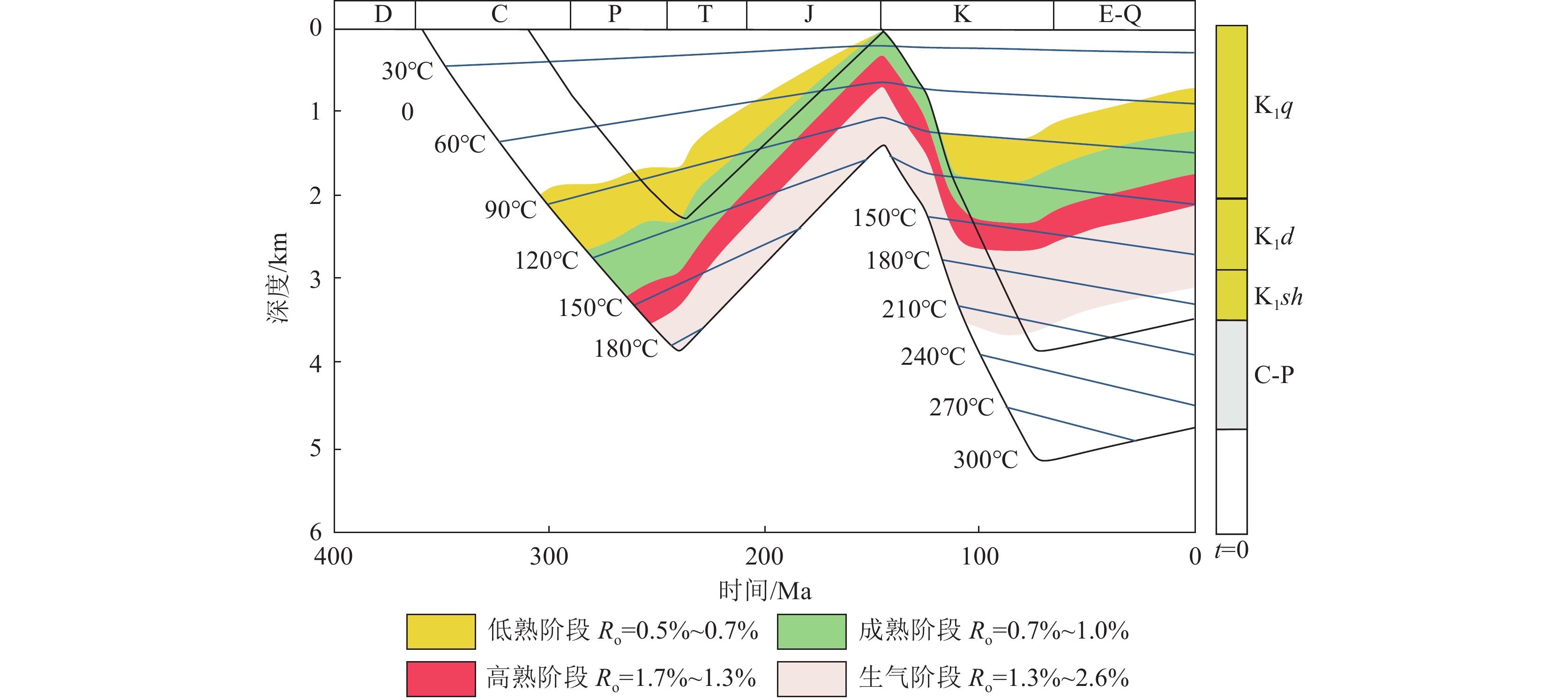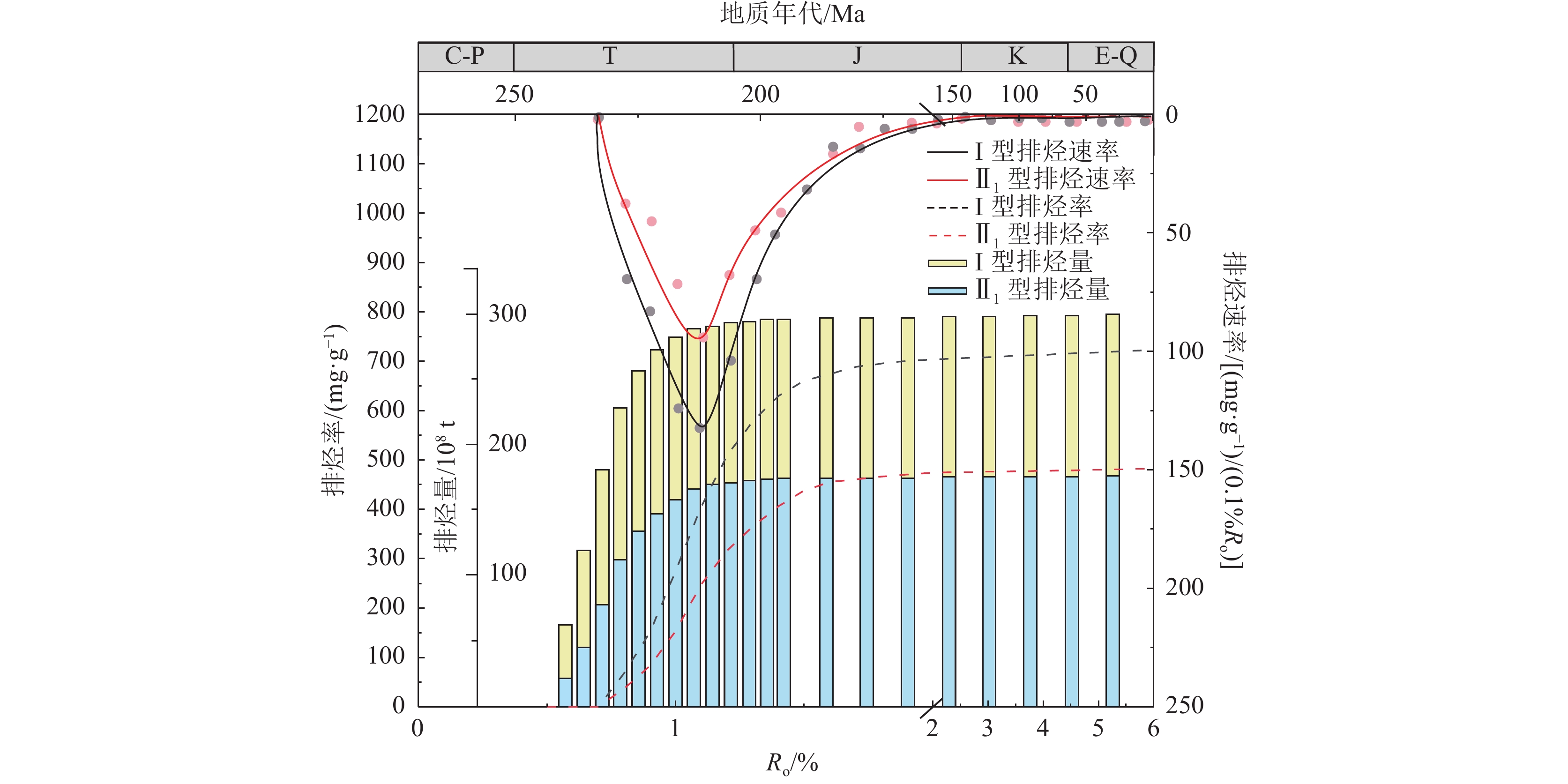Recovery of original quality characteristics and estimation of hydrocarbon expulsion of upper paleozoic source rocks in the Sishen 1 well area, Songliao Basin
-
摘要:
松辽盆地四深1井区基底古生界已发现天然气,但是烃源岩有机质热演化程度高,仅依据现今残余的有机质丰度和生烃潜力参数会极大降低烃源岩评价的准确性,误导油气远景的评估。利用岩石热解参数、有机碳同位素、镜质体反射率及有机显微组分等实验数据,通过多种方法恢复烃源岩原始有机质丰度及生烃潜力,确定降解率法的恢复结果可靠,进一步结合生烃潜力法分析热演化过程中烃源岩的排烃特征。结果表明,四深1井区古生界烃源岩大部分为Ⅰ型和Ⅱ1型有机质,恢复后的原始有机碳(TOC)平均值为2.56%,原始热解烃量(S2)平均值为16.11 mg/g,恢复后的原始烃源岩品质达到好—极好级别。基于Ⅰ和Ⅱ1型有机质热演化过程中烃源岩的排烃量曲线,得出四深1井区上古生界烃源岩在三叠纪早期(约230 Ma)进入排烃门限(Ro=0.7%),在三叠纪晚期(约210 Ma)到达排烃高峰(Ro=1.1%),原油主要成藏阶段在三叠纪—侏罗纪早期(230~200 Ma),排烃量为416.423×108 t。主要成气期在侏罗纪中晚期阶段(200~165 Ma),排烃量为55.093×108 t。研究表明,四深1井区上古生界烃源岩已经为油气藏的形成提供了丰富的烃源。
Abstract:Natural gas has been discovered in the basement of the Paleozoic strata in the Sishen 1 well area of the Songliao Basin. However, the organic matter in the source rocks was in the over mature stage. Based on residual TOC and rock pyrolysis, the evaluation accuracy of source rock was reduced significantly, and it could result in erroneous assessments of the oil and gas exploration potential. A bulk of experimental data encompassing rock pyrolysis parameters, isotopic ratios of organic carbon, vitrinite reflectance, organic maceral components and multiple recovery methodologies were employed to restore the original organic matter content and hydrocarbon generation potential of the Paleozoic source rocks. The degradation rate method was selected as the most reliable recovery method based on the recovery results. Subsequently, the expulsion characteristics of the source rocks throughout the thermal maturation process were analyzed, leveraging the hydrocarbon potential method. The findings indicated that the majority kerogen type of Paleozoic source rocks in the Sishen 1 well area were classified as Type I and Type II1. The average original total organic carbon (TOC) content was 2.56%, while the average original S2 value was calculated to be 16.11 mg/g. Consequently, the quality of the original source rocks was good to excellent. According to the hydrocarbon expulsion curves of I and II1 kerogen during thermal evolution, the Paleozoic source rocks in the Sishen 1 well area were found to have entered the hydrocarbon expulsion threshold during the Early Triassic (approximately 230 Ma), characterized by a vitrinite reflectance (Ro) value of 0.7%, and the peak of hydrocarbon expulsion was attained in the Late Triassic (approximately 210 Ma), with an Ro value of 1.1%. Oil accumulation was occurred from the Early Triassic to the Early Jurassic (approximately 230 Ma to 200 Ma), with an estimated expulsion volume of 416.423×108 t. Then, gas generation was happened during the Middle to Late Jurassic (approximately 200 Ma to 165 Ma), with an expulsion volume recorded at 55.093×108 t. The study has shown that that the Upper Paleozoic source rocks in the Sishen 1 well area have provided abundant source of hydrocarbons for the formation of oil and gas reservoirs.
-
-
图 1 研究区基底骨架断裂分布图(a)及地层柱状图(b)(王成文等, 2009; 邢大全等, 2015)
Figure 1. Distribution of basal skeleton fractures (a) and stratigraphic histogram (b) of the study area
图 2 生排烃模式图(Pang et al., 2005)
Figure 2. Pattern diagram of hydrocarbon expulsion from source rocks
图 7 不同盆地烃源岩生烃排烃模式图(据陈建平等,2014)
Figure 7. Hydrocarbon generation and drainage patterns of hydrocarbon source rocks in different basins
图 9 四深1井埋藏史图(据逯晓喻等,2013)
K1q—泉头组;K1d—登娄库组;K1sh—沙河子组;D—泥盆纪;C—石炭纪;P—二叠纪;T—三叠纪;J—侏罗纪;K—白垩纪;E−Q—新近纪−第四纪
Figure 9. The burial history of the Sishen 1 well
表 1 样品实测地球化学参数
Table 1 Measured geochemical parameters of the samples
样品编号 TOC/% TC/% TS/% S1/(mg·g−1) S2/(mg·g−1) δ13CTOC/‰ Tmax/℃ Ro/% 4S-1 2.42 3.07 1.12 0.26 0.04 −28.05 409 2.13 4S-2 1.41 1.45 0.02 0.01 0.01 −29.66 350 2.79 4S-3 1.52 1.6 1.51 0.01 0.02 −30.15 433 2.90 4S-5 1.86 2.21 2.87 0.01 0.02 −27.11 340 2.87 4S-6 1.67 1.95 6.67 0.01 0.03 −28.18 429 2.92 4S-7 1.23 1.44 1.37 0.01 0.06 −28.95 439 2.55 4S-8 1.67 2.35 1.18 0.13 1.17 −29.2 434 2.88 4S-9 1.38 1.38 0.94 0.01 0.03 −28.97 440 2.63 4S-10 0.62 0.74 0.03 0.01 0.02 −27.52 434 2.44 4S-11 1.03 1.1 0.7 0.05 0.03 −27.91 469 2.13 4S-12 2.61 2.77 1.69 5.14 3.20 −28.08 427 2.2 4S-13 1.72 1.83 1.57 0.06 0.12 −27.74 425 2.27 4S-14 1.39 1.49 0.85 0.02 0.01 −27.33 278 2.79 4S-15 1.16 1.29 0.11 0.53 0.62 −28.41 372 2.20 4S-16 1.7 1.84 0.71 0.01 0.01 −27.64 412 2.96 4S-17 1.38 1.44 0.11 0.07 0.02 −27.92 277 2.45 4S-18 1.35 1.91 0.12 0.03 0.41 −27.67 435 2.12 4S-19 1.36 1.73 1.39 0.27 0.33 −27.82 379 2.52 4S-20 1.13 1.99 0.15 0.10 0.01 −27.71 269 2.68 4S-21 1.26 1.77 0.09 0.11 0.09 −27.87 327 2.70 4S-22 1.29 2 0.61 0.11 0.02 −29.29 277 2.84 4S-23 1.99 2.2 0.38 0.31 0.33 −26.98 395 2.2 4S-24 1.36 2.33 3.06 0.07 0.09 −26.74 410 2.6 C1-1 1.04 1.06 2.56 0.11 4.88 −30.01 428 2.5 C8-1 0.6 0.63 3.08 0.01 0.04 −29.6 344 2.67 C8-2 0.33 0.48 1.57 0.01 0.03 −32.23 447 2.68 C8-3 1.13 1.18 0.78 0.02 0.04 −28.92 436 2.1 C8-4 1.01 1.28 0.63 0.04 0.11 −26.76 374 2.68 C8-5 0.74 1.07 0.61 0.04 0.12 −25.83 415 2.03 C8-6 0.83 0.88 0.7 0.02 0.05 −28.29 440 2.67 C8-7 0.73 1.05 0.35 0.03 0.08 −27.64 397 2.32 C8-8 0.74 1.13 0.17 0.03 0.06 −28.5 311 2.17 C8-9 1.03 1.33 0.13 0.03 0.09 −30.24 399 2.70 SC-1 2.21 2.41 2.4 2.54 1.59 −28.48 440 2.72 SC-2 0.27 0.73 3.17 0.01 0.02 −27.8 443 2.23 SC-3 0.58 1.41 2.14 0.96 2.85 −28.22 439 2.80 SC-4 1.91 1.98 1.52 0.03 0.05 −27.74 582 2.86 SC-5 0.38 0.79 1.32 0.08 0.03 −27.85 309 2.40 SC-6 2 2.3 1.8 0.16 0.11 −28.34 301 2.42 注:TOC—有机碳含量;TC—总碳含量;TS—总硫含量;S1—游离烃量;S2—热解烃量;δ13CTOC—有机碳同位素;Tmax—岩石热解最高峰温度;Ro—镜质体反射率 表 2 不同方法恢复后TOC相关参数变化
Table 2 Changes in TOC-related parameters after recovery by different methods
恢复方法 化学动力法 反演法 正演法 物质平衡法 降解率法 干酪根恢复系数法 恢复TOC范围/% 0.27~2.66 0.27~5.80 0.45~5.22 0.45~6.00 0.45~5.99 0.59~7.75 恢复TOC平均值/% 1.29 1.93 2.36 2.68 2.56 3.59 平均TOC恢复系数 1.01 1.38 1.83 2.07 1.97 2.76 恢复S2范围/(mg·g−1) 5.16~104.07 0.09~38.88 0.24~34.97 0.24~40.22 2.15~43.28 0.41~51.94 恢复S2平均值/(mg·g−1) 13.89 7.91 10.09 13.14 16.11 19.85 表 3 Ⅰ型有机质烃源岩排烃过程各参数变化
Table 3 Variation of parameters in the process of hydrocarbon removal from type Ⅰ organic hydrocarbon source rock
成烃期 Ro/% 生烃转化率/% GPI/(mg·g−1) 排烃率/(mg·g−1) 排烃速率/[(mg·g−1)/(0.1%Ro)] TOC/% 排烃强度/(104t/km2) 排烃量/(108 t) 未熟期 0.50 0.00 722.89 0.00 0.00 3.10 0 0 0.60 0.00 722.89 0.00 0.00 3.10 0 0 主要成油期 0.70 0.00 722.89 0.00 0.00 3.10 0 0 0.80 9.52 654.04 68.85 68.85 2.71 203.64 61.835 0.90 20.95 571.43 151.46 82.62 2.36 389.57 118.293 1.00 38.10 447.50 275.39 123.92 1.97 592.40 179.884 1.10 56.19 316.69 406.20 130.81 1.68 745.09 226.250 1.20 70.48 213.42 509.47 103.27 1.51 837.18 254.212 1.30 80.00 144.58 578.31 68.85 1.41 888.60 269.827 主要成气期 1.40 87.14 92.94 629.95 51.64 1.34 922.99 280.269 1.50 91.43 61.96 660.93 30.98 1.31 942.13 286.081 1.60 93.33 48.19 674.70 13.77 1.29 950.31 288.565 1.70 95.24 34.42 688.47 13.77 1.27 958.29 290.990 1.80 96.19 27.54 695.35 6.88 1.27 962.22 292.181 1.90 96.95 22.03 700.86 5.51 1.26 965.32 293.124 2.00 97.33 19.28 703.61 2.75 1.26 966.86 293.592 过熟期 2.50 97.67 16.87 706.02 0.48 1.26 968.21 294.000 3.00 98.00 14.46 708.43 0.48 1.25 969.54 294.406 3.50 98.33 12.05 710.84 0.48 1.25 970.88 294.811 4.00 98.67 9.64 713.25 0.48 1.25 972.20 295.214 4.50 99.00 7.23 715.66 0.48 1.25 973.53 295.615 5.00 99.33 4.82 718.07 0.48 1.24 974.84 296.015 5.50 99.67 2.41 720.48 0.48 1.24 976.15 296.413 6.00 100.00 0.00 722.89 0.48 1.24 977.46 296.809 表 4 Ⅱ1型有机质烃源岩排烃过程各参数变化
Table 4 Variation of parameters in the hydrocarbon drainage process of type Ⅱ1 organic hydrocarbon source rock
成烃期 Ro/% 生烃转化率/% GPI/(mg·g−1) 排烃率/(mg·g−1) 排烃速率/[(mg·g−1)/(0.1%Ro)] TOC/% 排烃强度/(104t/km2) 排烃量/(108 t) 未熟期 0.50 0.00 481.93 0.00 0.00 2.06 0.00 0 0.60 0.00 481.93 0.00 0.00 2.06 0.00 0 主要成油期 0.70 0.00 481.93 0.00 0.00 2.06 0.00 0 0.80 0.08 444.28 37.65 37.65 1.95 71.21 21.622 0.90 0.17 399.10 82.83 45.18 1.84 147.87 44.901 1.00 0.32 327.56 154.37 71.54 1.69 253.10 76.856 1.10 0.52 233.43 248.49 94.13 1.53 367.96 111.731 1.20 0.66 165.66 316.27 67.77 1.43 437.77 132.929 1.30 0.76 116.72 365.21 48.95 1.37 482.78 146.597 主要成气期 1.40 0.84 75.30 406.63 41.42 1.32 517.81 157.236 1.50 0.91 43.67 438.25 31.63 1.28 542.89 164.850 1.60 0.95 26.36 455.57 17.32 1.26 556.05 168.846 1.70 0.96 21.08 460.84 5.27 1.25 559.98 170.039 1.80 0.97 15.06 466.87 6.02 1.25 564.42 171.390 1.90 0.98 11.30 470.63 3.77 1.24 567.18 172.227 2.00 0.98 7.53 474.40 3.77 1.24 569.92 173.059 过熟期 2.50 0.99 6.59 475.34 0.19 1.24 570.60 173.266 3.00 0.99 5.65 476.28 0.19 1.24 571.28 173.473 3.50 0.99 4.71 477.22 0.19 1.24 571.96 173.679 4.00 0.99 3.77 478.16 0.19 1.24 572.64 173.885 4.50 0.99 2.82 479.10 0.19 1.24 573.32 174.091 5.00 1.00 1.88 480.05 0.19 1.23 574.00 174.297 5.50 1.00 0.94 480.99 0.19 1.23 574.67 174.502 6.00 1.00 0.00 481.93 0.19 1.23 575.35 174.707 -
Bai H, Pang X Q, Kuang L C, et al. 2017. Hydrocarbon expulsion potential of source rocks and its influence on the distribution of lacustrine tight oil reservoir, Middle Permian Lucaogou Formation, Jimsar Sag, Junggar Basin, Northwest China[J]. Journal of Petroleum Science and Engineering, 149: 740−755. doi: 10.1016/j.petrol.2016.09.053
Baskin D K. 1997. Atomic H/C ratio of kerogen as an estimate of thermal maturity and organic matter conversion[J]. AAPG Bulletin, 81(9): 1437−1450.
Cao Q Y. 1985. Identification of micro−components and types of kerogen under the transmitted light[J]. Petroleum Exploration and Development, 12(5): 14−32(in Chinese with English abstract).
Chen J P, Sun Y G, Zhong N N, et al. 2014. The efficiency and model of petroleum expulsion from the lacustrine source rocks within geological frame[J]. Acta Geologica Sinica, 88(11): 2005−2032(in Chinese with English abstract).
Cheng K M, Wang Z Y. 1996. An evaluation method of hydrocarbon generating potential of highly mature and over−mature marine carbonate[J]. Science in China( Series D), 26(6): 537−543(in Chinese with English abstract).
Cornford C, Gardner P, Burgess C. 1998. Geochemical truths in large data sets. I: Geochemical screening data[J]. Organic Geochemistry, 29(1): 519−530.
Craig J, Luening S, Beswetherick S, et al. 2008. Structural styles and prospectivity in the Precambrian and Palaeozoic hydrocarbon systems of North Africa[J]. Geology of East Libya, 4: 51−122.
Espitalie J. 1986. Use of Tmax as a maturation index for different types of organic matter, Comparison with vitrinite reflectance[M]. Paris: Editions Technip: 475−496.
Fu W, Hou H, Gao R, et al. 2021. Lithospheric structures of the central Solonker−Xar Moron−Changchun−Yanji Suture (Inner Mongolia) revealed by a deep seismic reflection profile[J]. Tectonophysics, 817: 229043. doi: 10.1016/j.tecto.2021.229043
Hakimi M H, Abdullah W H. 2014. Source rock characteristics and hydrocarbon generation modelling of Upper Cretaceous Mukalla Formation in the Jiza−Qamar Basin, Eastern Yemen[J]. Marine and Petroleum Geology, 51: 100−116. doi: 10.1016/j.marpetgeo.2013.11.022
Hu T, Pang X Q, Yu S, et al. 2016. Hydrocarbon generation and expulsion characteristics of Lower Permian P1f source rocks in the Fengcheng area, northwest margin, Junggar Basin, NW China: implications for tight oil accumulation potential assessment[J]. Geological Journal, 51(6): 880−900. doi: 10.1002/gj.2705
Huang D F, Li J C, Zhang D J. 1984. Kerogen types and study on effectiveness, limitation and interrelation of their identification parameters[J]. Acta Sedimentologica Sinica, 2(3): 18−33(in Chinese with English abstract).
Huang Z L, Wang B, Zhang X Q, et al. 2013. Evaluation on gas generation potential of Upper Paleozoic source rock in Songliao Basin[J]. Journal of Earth Sciences & Environment, 35(3): 55−65(in Chinese with English abstract).
Hunt J M. 1979. Petroleum geochemistry and geology[M]. New York: Freman.
Jarvie D M, Hill R J, Ruble T E, et al. 2007. Unconventional shale−gas systems: The mississippian Barnett Shale of north−central Texas as one model for thermogenic shale−gas assessment[J]. AAPG Bulletin, 91(4): 475−499. doi: 10.1306/12190606068
Jia C Z, Pang X Q. 2015. Research processes and main development directions of deep hydrocarbon geological theories[J]. Acta Petrolei Sinica, 36(12): 1457.
Jia J, Bechtel A, Liu Z, et al. 2013. Oil shale formation in the Upper Cretaceous Nenjiang Formation of the Songliao Basin (NE China): Implications from organic and inorganic geochemical analyses[J]. International Journal of Coal Geology, 113: 11−26. doi: 10.1016/j.coal.2013.03.004
Jiang H, Pang X Q, Shi H S, et al. 2015. Source rock characteristics and hydrocarbon expulsion potential of the Middle Eocene Wenchang formation in the Huizhou depression, Pearl River Mouth basin, south China sea[J]. Marine and Petroleum Geology, 67: 635−652. doi: 10.1016/j.marpetgeo.2015.06.010
Jin Q. 1989. The restoration of initial organic carbon in source rocks[J]. Journal of the University of Petroleum, China,13(5): 1−10(in Chinese with English abstract).
Li C R, Pang X Q, Huo Z P, et al. 2020. A revised method for reconstructing the hydrocarbon generation and expulsion history and evaluating the hydrocarbon resource potential: Example from the first member of the Qingshankou Formation in the Northern Songliao Basin, Northeast China[J]. Marine and Petroleum Geology, 121: 104577. doi: 10.1016/j.marpetgeo.2020.104577
Li C R, Pang X Q, Ma X H, et al. 2021. Hydrocarbon generation and expulsion characteristics of the Lower Cambrian Qiongzhusi shale in the Sichuan Basin, Central China: Implications for conventional and unconventional natural gas resource potential[J]. Journal of Petroleum Science and Engineering, 204: 108610. doi: 10.1016/j.petrol.2021.108610
Lu S F, Liu X Y, Qu J Y, et al. 1995. Restoring of original hydrocarbon potential and original organic carbon of source rocks in Huhehu Depression Hailar Basin[J]. Journal of Daqing Petroleum Institute, 19(1): 31−34(in Chinese with English abstract).
Lu X Y, Huang Z L, Wang B, et al. 2013. Research of Carboniferous−Permian thermal history in Zhaoyuan area of Songliao basin[J]. Natural Gas Geoscience, 24(3): 548−554(in Chinese with English abstract).
Ma Z Z, Pang X Q, Sun J K, et al. 2009. Some problems about implication of hydrocarbon−generation potential method on research the expulsion characteristics of source rocks[J]. Journal of Southwest Petroleum University (Science & Technology Edition), 31(1): 14−18(in Chinese with English abstract).
Niu D M, Sun P C, Bai Y Y, et al. 2023. An FR–IR model method for restoring the original organic geochemical parameters of high over−mature source rocks with types I and II kerogen in China[J]. Geoenergy Science and Engineering, 228: 211971. doi: 10.1016/j.geoen.2023.211971
Pang X Q, Li M W, Li S M, et al. 2005. Geochemistry of petroleum systems in the Niuzhuang South Slope of Bohai Bay Basin: Part 3. Estimating hydrocarbon expulsion from the Shahejie formation[J]. Organic Geochemistry, 36(4): 497−510. doi: 10.1016/j.orggeochem.2004.12.001
Pang X Q, Li Q W, Chen J F. 2014. Recovery method of original TOC and its application in source rocks at high mature−over mature stage in deep petroliferous basins[J]. Journal of Palaeogeography, 16(6): 769−789(in Chinese with English abstract).
Peng J W, Pang X Q, Shi H S, et al. 2016. Hydrocarbon generation and expulsion characteristics of Eocene source rocks in the Huilu area, northern Pearl River Mouth basin, South China Sea: Implications for tight oil potential[J]. Marine and Petroleum Geology, 72: 463−487. doi: 10.1016/j.marpetgeo.2016.02.006
Peters K E, Cassa M R. 1994. Applied source rock geochemistry[J]. AAPG, Memoirs.60: 93−117.
Ren S M, Qiao D W, Zhang X Z, et al. 2011. The present situation of oil & gas resources exploration and strategic selection of potential area in the Upper Paleozoic of Songliao Basin and surrounding area, NE China[J]. Geological Bulletin of China, 30(2/3): 197−204(in Chinese with English abstract).
Ren Z L, Xiao D M, Chi Y L, et al. 2011. Restoration of thermal history of the Permo−Carboniferous basement in the Songliao Basin[J]. Oil & Gas Geology, 32(3): 430−439(in Chinese with English abstract).
Schwangler M, Harris N B, Waldron J W F. 2020. Source rock characterization and oil−to−source rock correlation of a Cambrian−Ordovician fold−and−thrust belt petroleum system, western Newfoundland[J]. Marine and Petroleum Geology, 115: 104283. doi: 10.1016/j.marpetgeo.2020.104283
Shi C H, Cao J, Selby D, et al. 2020. Hydrocarbon evolution of the over−mature Sinian Dengying reservoir of the Neoproterozoic Sichuan Basin, China: Insights from Re–Os geochronology[J]. Marine and Petroleum Geology, 122: 104726. doi: 10.1016/j.marpetgeo.2020.104726
Song Y, Ren J, Liu K, et al. 2018. Post−rift anomalous thermal flux in the Songliao Basin, NE China, as revealed from fission track thermochronology and tectonic analysis[J]. Palaeogeography, Palaeoclimatology, Palaeoecology, 508: 148−165.
Song Y, Ren J, Stepashko A A, et al. 2014. Post−rift geodynamics of the Songliao Basin, NE China: Origin and significance of T11 (Coniacian) unconformity[J]. Tectonophysics, 634: 1−18. doi: 10.1016/j.tecto.2014.07.023
Tissot B, Welte D H. 1984. Petroleum formation and occurence[M]. Berlin Heidelberg New York: 699.
Wang C W, Sun Y W, Li N, et al. 2009. On the distribution of late Palaeozoic strata in Northeast China[J]. Journal of Stratigraphy, 33(1): 56−61(in Chinese with English abstract).
Wang E, Liu G Y, Pang X Q, et al. 2020. An improved hydrocarbon generation potential method for quantifying hydrocarbon generation and expulsion characteristics with application example of Paleogene Shahejie Formation, Nanpu Sag, Bohai Bay Basin[J]. Marine and Petroleum Geology, 112: 104106. doi: 10.1016/j.marpetgeo.2019.104106
Wang Z, Wang J, Yu F, et al. 2021. Geochemical characteristics of the Upper Triassic black mudstones in the eastern Qiangtang Basin, Tibet: Implications for petroleum potential and depositional environment[J]. Journal of Petroleum Science and Engineering, 207: 109180. doi: 10.1016/j.petrol.2021.109180
Xiao D, Cao J, Luo B, et al. 2021. Neoproterozoic postglacial paleoenvironment and hydrocarbon potential: A review and new insights from the Doushantuo Formation Sichuan Basin, China[J]. Earth−Science Reviews, 212: 103453. doi: 10.1016/j.earscirev.2020.103453
Xing D Q, Liu Y J, Tang Z X, et al. 2015. Research on Upper Paleozoic tectonic framework and evolution of Songliao Basin[J]. Global Geology, 34(2): 396−407(in Chinese with English abstract).
Zhao Q F, Xie D Z, Chen J W, et al. 2023. Evaluation and biogenetic derivation and sedimentary environment of source rocks from Permian in the Lower Yangze region[J]. Geological Bulletin of China, 42(7): 1154−1165 (in Chinese with English abstract).
Zhao Z K, Jiang T, He J L. 2011. The oil and gas exploration prospect of Carboniferous—Permian in Songliao basin, northeastern China[J]. Geological Bulletin of China, 30(2): 221−227(in Chinese with English abstract).
Zheng D Y, Pang X Q, Ma X H, et al. 2019. Hydrocarbon generation and expulsion characteristics of the source rocks in the third member of the Upper Triassic Xujiahe Formation and its effect on conventional and unconventional hydrocarbon resource potential in the Sichuan Basin[J]. Marine and Petroleum Geology, 109: 175−192. doi: 10.1016/j.marpetgeo.2019.06.014
Zheng Y J, Huang X, Sun Y W, et al. 2018. The Carboniferous−Permian stratigraphic division and correlation in the Songliao Basin and its peripheral areas[J]. Geology and Resources, 27(1): 1−15(in Chinese with English abstract).
Zhu D F, Ren Y G, Wu H Y, et al. 2007. A preliminary study on the buried Permian and Jurassic in the Northern Songliao Basin[J]. Chinese Journal of Geology, 42(4): 690−708,778(in Chinese with English abstract).
Zhu G Y, Zhang Z Y, Zhou X X, et al. 2019. The complexity, secondary geochemical process, genetic mechanism and distribution prediction of deep marine oil and gas in the Tarim Basin, China[J]. Earth−Science Reviews, 198: 102930. doi: 10.1016/j.earscirev.2019.102930
Zhu G, Jiang D Z, Zhang B L, et al. 2012. Destruction of the eastern North China Craton in a backarc setting: Evidence from crustal deformation kinematics[J]. Gondwana Research, 22(1): 86−103. doi: 10.1016/j.gr.2011.08.005
曹庆英. 1985. 透射光下干酪根显微组分鉴定及类型划分[J]. 石油勘探与开发, (5): 14−23,81−88. 陈建平, 孙永革, 钟宁宁, 等. 2014. 地质条件下湖相烃源岩生排烃效率与模式[J]. 地质学报, 88(11): 2005−2032. 程克明, 王兆云. 1996. 高成熟和过成熟海相碳酸盐岩生烃条件评价方法研究[J]. 中国科学(D辑: 地球科学), (6): 537−543. 黄第藩, 李晋超, 张大江. 1984. 干酪根的类型及其分类参数的有效性、局限性和相关性[J]. 沉积学报, (3): 18−33,135−136. 黄志龙, 王斌, 张秀颀, 等. 2013. 松辽盆地上古生界烃源岩生气潜力评价[J]. 地球科学与环境学报, 35(3): 55−65. doi: 10.3969/j.issn.1672-6561.2013.03.005 金强. 1989. 生油岩原始有机碳恢复方法的探讨[J]. 石油大学学报(自然科学版), (5): 1−10. 卢双舫, 刘晓艳, 曲佳燕, 等. 1995. 海拉尔盆地呼和湖凹陷烃源岩原始生烃潜力和原始有机碳的恢复[J]. 大庆石油学院学报, (1): 31−34. 逯晓喻, 黄志龙, 王斌, 等. 2013. 松辽盆地肇源地区石炭系—二叠系热演化史研究[J]. 天然气地球科学, 24(3): 548−554. 马中振, 庞雄奇, 孙俊科, 等. 2009. 生烃潜力法在排烃研究中应注意的几个问题[J]. 西南石油大学学报(自然科学版), 31(1): 14−18. 庞雄奇, 李倩文, 陈践发, 等. 2014. 含油气盆地深部高过成熟烃源岩古TOC恢复方法及其应用[J]. 古地理学报, 16(6): 769−789. doi: 10.7605/gdlxb.2014.06.062 任收麦, 乔德武, 张兴洲, 等. 2011. 松辽盆地及外围上古生界油气资源战略选区研究进展[J]. 地质通报, 30(2/3): 197−204. doi: 10.3969/j.issn.1671-2552.2011.02.003 任战利, 萧德铭, 迟元林, 等. 2011. 松辽盆地基底石炭—二叠系热演化史[J]. 石油与天然气地质, 32(3): 430−439. 王成文, 孙跃武, 李宁, 等. 2009. 东北地区晚古生代地层分布规律[J]. 地层学杂志, 33(1): 56−61. doi: 10.3969/j.issn.0253-4959.2009.01.006 邢大全, 刘永江, 唐振兴, 等. 2015. 松辽盆地上古生界构造格局及演化探究[J]. 世界地质, 34(2): 396−407. doi: 10.3969/j.issn.1004-5589.2015.02.015 赵青芳, 谢德智, 陈建文, 等. 2023. 下扬子区二叠系烃源岩评价与生源环境[J]. 地质通报, 42(7): 1154−1165. 赵志魁, 江涛, 贺君玲. 2011. 松辽盆地石炭系—二叠系油气勘探前景[J]. 地质通报, 30(2): 221−227. doi: 10.3969/j.issn.1671-2552.2011.02.006 郑月娟, 黄欣, 孙跃武, 等. 2018. 松辽盆地及外围石炭系—二叠系划分与对比[J]. 地质与资源, 27(1): 1−15. doi: 10.3969/j.issn.1671-1947.2018.01.001 朱德丰, 任延广, 吴河勇, 等. 2007. 松辽盆地北部隐伏二叠系和侏罗系的初步研究[J]. 地质科学, (4): 690−708, 778.



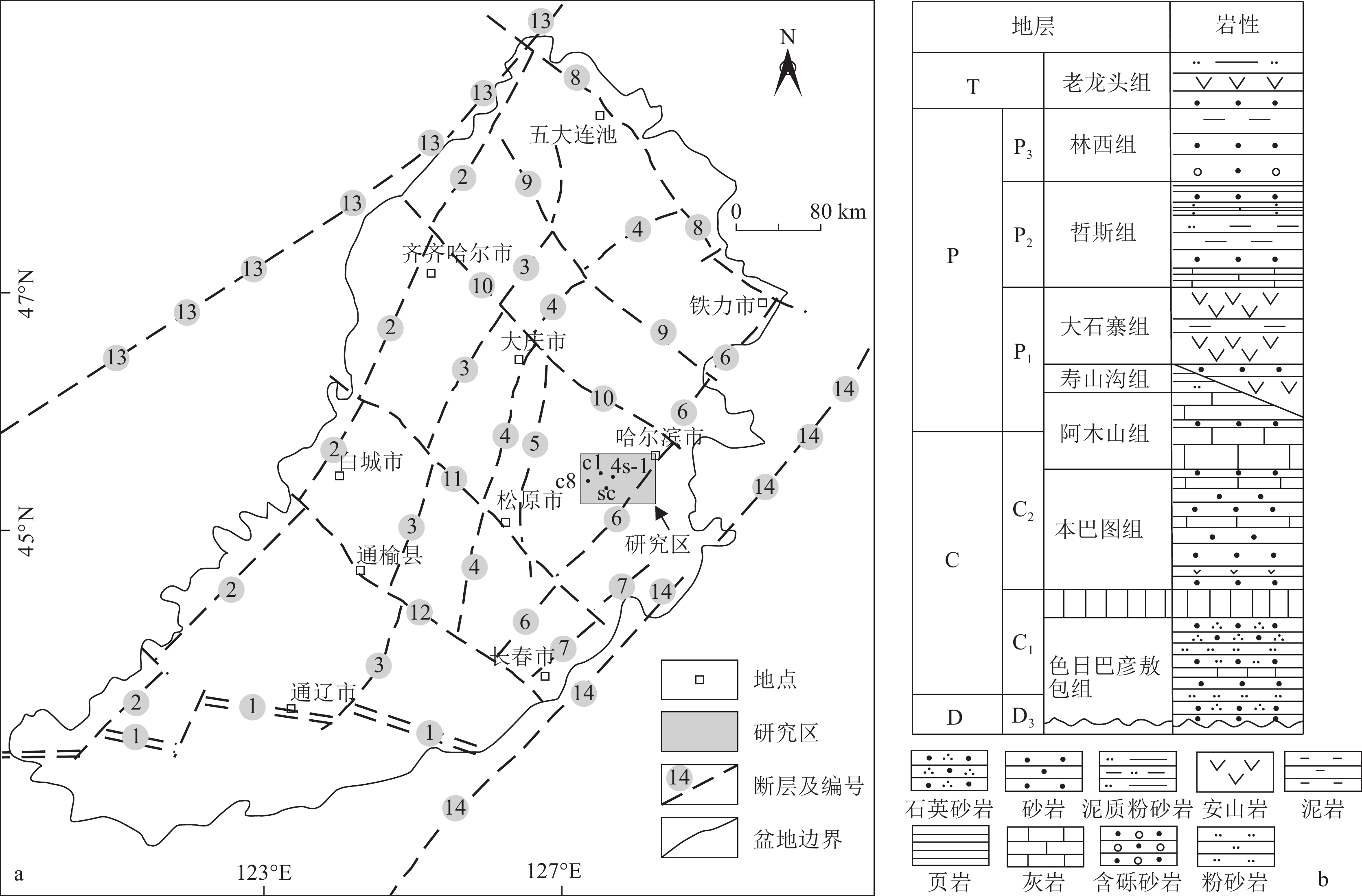
 下载:
下载:
